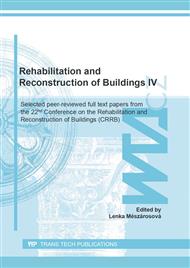[1]
G. Hanswille, M. Porsch, Lasteinleitung bei ausbetonierten Hohlprofil-Verbundstützen, Stahlbau. 73(2004) 676-682.
DOI: 10.1002/stab.200490171
Google Scholar
[2]
T.A.C. Pires, J.P.C. Rodrigues and J.J.R. Silva, Fire resistance of concrete filled circular hollow columns with restrained thermal elongation, J. Constr. Steel Res. 77 (2012) 82-94.
DOI: 10.1016/j.jcsr.2012.03.028
Google Scholar
[3]
J. Yin, X. Zha, and L. Li, Fire resistance of axially loaded concrete filled steel tube columns, J. Constr. Steel Res. 62 (2006) 723-729.
DOI: 10.1016/j.jcsr.2005.11.011
Google Scholar
[4]
A. Espinos, M.L. Romero, E. Serra, and A. Hospitaler, Circular and square slender concrete-filled tubular columns under large eccentricities and fire, J. Constr. Steel Res. 110 (2015) 90-100.
DOI: 10.1016/j.jcsr.2015.03.011
Google Scholar
[5]
P.C. Aïtcin, Ultra high strength concrete, in: P.C. Aïtcin, R.J. Flatt (Eds.), Science and Technology of Concrete Admixtures, Woodhead Publishing, Cambridge, 2016, pp.503-523.
DOI: 10.1016/b978-0-08-100693-1.00027-8
Google Scholar
[6]
P. Bukovská and M. Karmazínová, Effectiveness of high-strength concrete when used in circular steel tubes filled with concrete, Proc. Recent Advances in Engineering, WSEAS Press, Paris, (2012).
Google Scholar
[7]
C. Ibañez, J.M. Portolés, M.L. Romero, A. Espinos and V. Albero, Ultra-high Strength Concrete on Eccentrically Loaded Slender Circular Concrete-filled Dual Steel Columns, Structures. 12 (2017) 64-74.
DOI: 10.1016/j.istruc.2017.07.005
Google Scholar
[8]
J.M. Portolés, E. Serra and M.L. Romero, Influence of ultra-high strength infill in slender concrete-filled steel tubular columns, J Constr. Steel Res. 86 (2013), 107-14.
DOI: 10.1016/j.jcsr.2013.03.016
Google Scholar
[9]
F. Demir, A new way of prediction elastic modulus of normal and high strength concrete-fuzzy logic, Cem. and Concr. Res. 35 (2005) 1531-1538.
DOI: 10.1016/j.cemconres.2005.01.001
Google Scholar
[10]
Y. Kezhen and S. Caijun, Prediction of elastic modulus of normal and high strength concrete by support vector machine, Constr. and Build. Mat. 24 (2010) 1479-1485.
DOI: 10.1016/j.conbuildmat.2010.01.006
Google Scholar


